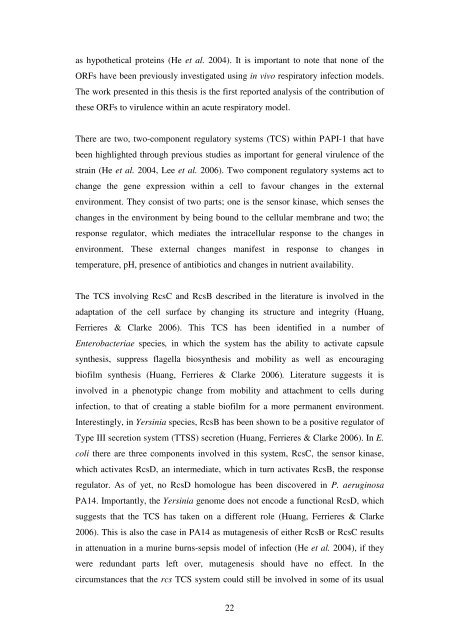5 The role of quorum-sensing in the virulence of Pseudomonas ...
5 The role of quorum-sensing in the virulence of Pseudomonas ...
5 The role of quorum-sensing in the virulence of Pseudomonas ...
Create successful ePaper yourself
Turn your PDF publications into a flip-book with our unique Google optimized e-Paper software.
as hypo<strong>the</strong>tical prote<strong>in</strong>s (He et al. 2004). It is important to note that none <strong>of</strong> <strong>the</strong><br />
ORFs have been previously <strong>in</strong>vestigated us<strong>in</strong>g <strong>in</strong> vivo respiratory <strong>in</strong>fection models.<br />
<strong>The</strong> work presented <strong>in</strong> this <strong>the</strong>sis is <strong>the</strong> first reported analysis <strong>of</strong> <strong>the</strong> contribution <strong>of</strong><br />
<strong>the</strong>se ORFs to <strong>virulence</strong> with<strong>in</strong> an acute respiratory model.<br />
<strong>The</strong>re are two, two-component regulatory systems (TCS) with<strong>in</strong> PAPI-1 that have<br />
been highlighted through previous studies as important for general <strong>virulence</strong> <strong>of</strong> <strong>the</strong><br />
stra<strong>in</strong> (He et al. 2004, Lee et al. 2006). Two component regulatory systems act to<br />
change <strong>the</strong> gene expression with<strong>in</strong> a cell to favour changes <strong>in</strong> <strong>the</strong> external<br />
environment. <strong>The</strong>y consist <strong>of</strong> two parts; one is <strong>the</strong> sensor k<strong>in</strong>ase, which senses <strong>the</strong><br />
changes <strong>in</strong> <strong>the</strong> environment by be<strong>in</strong>g bound to <strong>the</strong> cellular membrane and two; <strong>the</strong><br />
response regulator, which mediates <strong>the</strong> <strong>in</strong>tracellular response to <strong>the</strong> changes <strong>in</strong><br />
environment. <strong>The</strong>se external changes manifest <strong>in</strong> response to changes <strong>in</strong><br />
temperature, pH, presence <strong>of</strong> antibiotics and changes <strong>in</strong> nutrient availability.<br />
<strong>The</strong> TCS <strong>in</strong>volv<strong>in</strong>g RcsC and RcsB described <strong>in</strong> <strong>the</strong> literature is <strong>in</strong>volved <strong>in</strong> <strong>the</strong><br />
adaptation <strong>of</strong> <strong>the</strong> cell surface by chang<strong>in</strong>g its structure and <strong>in</strong>tegrity (Huang,<br />
Ferrieres & Clarke 2006). This TCS has been identified <strong>in</strong> a number <strong>of</strong><br />
Enterobacteriae species, <strong>in</strong> which <strong>the</strong> system has <strong>the</strong> ability to activate capsule<br />
syn<strong>the</strong>sis, suppress flagella biosyn<strong>the</strong>sis and mobility as well as encourag<strong>in</strong>g<br />
bi<strong>of</strong>ilm syn<strong>the</strong>sis (Huang, Ferrieres & Clarke 2006). Literature suggests it is<br />
<strong>in</strong>volved <strong>in</strong> a phenotypic change from mobility and attachment to cells dur<strong>in</strong>g<br />
<strong>in</strong>fection, to that <strong>of</strong> creat<strong>in</strong>g a stable bi<strong>of</strong>ilm for a more permanent environment.<br />
Interest<strong>in</strong>gly, <strong>in</strong> Yers<strong>in</strong>ia species, RcsB has been shown to be a positive regulator <strong>of</strong><br />
Type III secretion system (TTSS) secretion (Huang, Ferrieres & Clarke 2006). In E.<br />
coli <strong>the</strong>re are three components <strong>in</strong>volved <strong>in</strong> this system, RcsC, <strong>the</strong> sensor k<strong>in</strong>ase,<br />
which activates RcsD, an <strong>in</strong>termediate, which <strong>in</strong> turn activates RcsB, <strong>the</strong> response<br />
regulator. As <strong>of</strong> yet, no RcsD homologue has been discovered <strong>in</strong> P. aerug<strong>in</strong>osa<br />
PA14. Importantly, <strong>the</strong> Yers<strong>in</strong>ia genome does not encode a functional RcsD, which<br />
suggests that <strong>the</strong> TCS has taken on a different <strong>role</strong> (Huang, Ferrieres & Clarke<br />
2006). This is also <strong>the</strong> case <strong>in</strong> PA14 as mutagenesis <strong>of</strong> ei<strong>the</strong>r RcsB or RcsC results<br />
<strong>in</strong> attenuation <strong>in</strong> a mur<strong>in</strong>e burns-sepsis model <strong>of</strong> <strong>in</strong>fection (He et al. 2004), if <strong>the</strong>y<br />
were redundant parts left over, mutagenesis should have no effect. In <strong>the</strong><br />
circumstances that <strong>the</strong> rcs TCS system could still be <strong>in</strong>volved <strong>in</strong> some <strong>of</strong> its usual<br />
22














